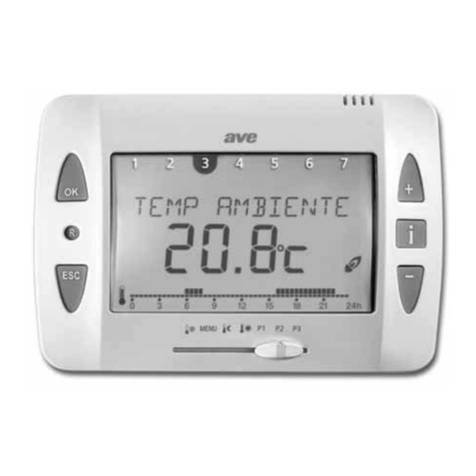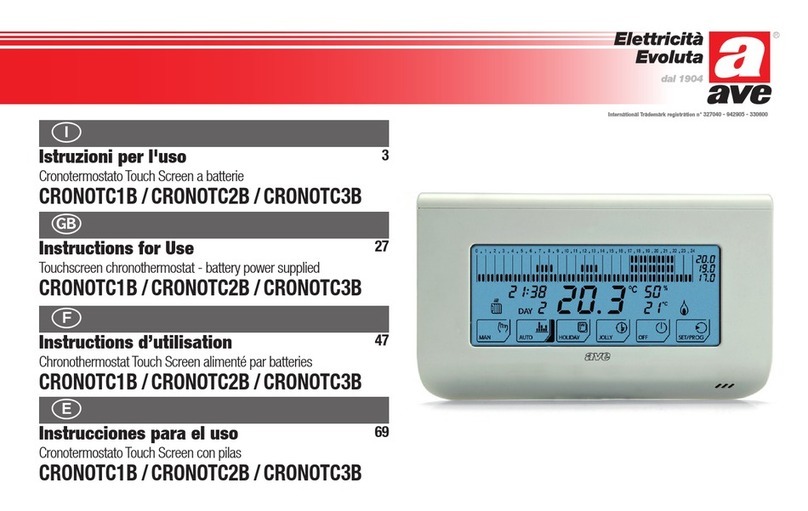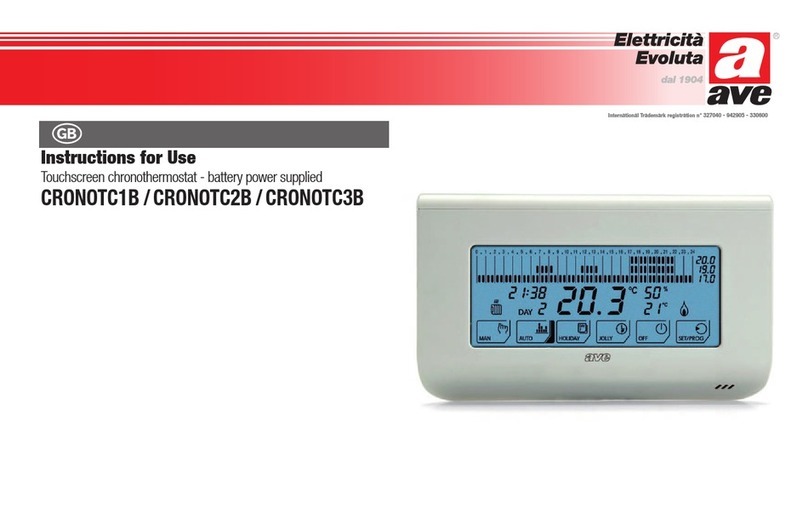
5 Funzioni e modalità di configurazione
La pressione contemporanea dei tasti e , per almeno 5 secondi, permetterà
l’accesso al menu di configurazione.
Nel menù di configurazione, premendo il pulsante , si potrà selezionare/passa-
re alla voce desiderata ed, una volta selezionata, tramite i pulsanti emodi-
ficarne l’impostazione. L’uscita dal menu di configurazione potrà essere fatta pre-
mendo in ogni situazione il pulsante , oppure attendendo la scadenza del time-
out di circa 60 sesondi.
I passi di configurazione sono proposti nella sequenza ciclica con cui vengono
presentati sul display:
5.1 Blocco tastiera
La funzione “blocco tastiera” permette di bloccare la tastiera per evitare di modifi-
care accidentalmente il setpoint (valore di temperatura desiderato) impostato e/o
lo stato di funzionamento del termostato. Tramite i pulsanti everrà visua-
lizzata alternativamente la scritta “OFF/ ”con il simbolo , ad indicare rispet-
tivamente la condizione del blocco disattivato/attivato.
Nota: l’attivazione del blocco tastiera non inibisce l’accesso al menu di configura-
zione, necessario ad impostarne la disattivazione.
Condizione di fabbrica: OFF
5.2 Regime di funzionamento: Estate o Inverno
Tramite i pulsanti everranno visualizzati alternativamente i simboli e
, ad indicare il regime di funzionamento del termostato (rispettivamente esta-
te=condizionamento o inverno=riscaldamento).
Condizione di fabbrica: Inverno ( )
5.3 Riduzione
Ilvalore di “riduzione”èunvalore “assoluto” che verràsommatoalsetpoint impo-
stato per ottenere una riduzione di consumo, tipicamente richiesta nelle ore not-
7
ITALIANO
turne. Il valore di “riduzione” verrà visualizzato con il segno “- (meno)” nel caso il
termostato sia in regime di funzionamento “Inverno”, con il segno “+ (più)” nel
caso il termostato sia in regime di funzionamento “Estate” (a significare che tale
valoreverràsottrattoosommatoalsetpointimpostatoaseconda del regime difun-
zionamento); tale valore verrà visualizzato assieme al simbolo di riduzione not-
turna. Tramite i pulsanti esi potrà eseguire una regolazione tra -0,5 e -5,0
°C nel caso il termostato si trovi in regime di funzionamento “Inverno” (oppure tra
+0,5 e +5,0 °C nel caso il termostato si trovi in regime di funzionamento “Estate”).
Condizione di fabbrica: 3,0 °C
5.4 Soglia antigelo
Il valore impostato verrà visualizzato assieme al simbolo (antigelo). Il valore di
“soglia antigelo” è un valore di temperatura di sicurezza al di sotto della quale il
termostato attiverà il relè d’uscita anche se spento (stato di funzionamento OFF).
Tramite i pulsanti esi potrà eseguire una regolazione tra +2,0 e +10,0 °C.
Condizione di fabbrica: 5,0 °C
5.5 Compensazione termica
Nelcasoin cui non sia stato possibilemontare il termostato in una posizioneidea-
le, ossia se il termostato si trova su una parete esterna, accanto al camino, ecc.,
potrebbero verificarsi delle differenze fra la temperatura rilevata dal termostato e la
temperatura ambiente effettiva. Per questi casi, sussiste la possibilità di imposta-
re una compensazione termica (esempio: la differenza fra la temperatura ambiente
effettiva e quella indicata dal termostato è di 2 °C, ossia la temperatura ambiente
viene indicata con 2 °C superiori: valore di compensazione -2 °C).
Il valore impostato verrà visualizzato con una scritta “ 0.0”. Tramite i pulsanti
esi potrà eseguire una regolazione tra -5,0 e +5,0 °C.
Condizione di fabbrica: 0
5.6 Differenziale termico (isteresi)
Per differenziale termico si intende la differenza tra il valore di temperatura impo-
stato e l’effettiva temperatura di accensione o di spegnimento dell’impianto.
C.539rev01 18-07-2008 16:33 Pagina 7































